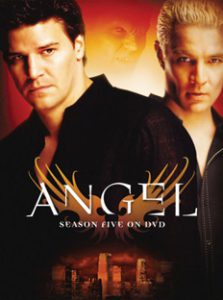“Angel” Season 5 (2003-04, The WB) sends the series out with a bang, ironically because it’s a season of intriguing fresh starts. Unlike with the final season of “Buffy” one year before this, Joss Whedon did not intend for this to be the final season of “Angel” (the WB’s cancellation announcement came while episode 17 was being shot).
The final couple of episodes do a respectable job of giving a grace note to the series while sticking with what I assume was the planned story thrust of a big battle between Angel’s team and the Wolfram & Hart senior partners in Season 6 (which became the “After the Fall” comic-book series).
I struggle a bit with Angel dropping his “If nothing we do matters, the only thing that matters is what we do” mantra and opting to kick some W&H butt at the risk of the world as we know it, but it certainly provided an epic note for the unavoidably abrupt end to the series.

“Angel” Season 5 (2003-04)
WB, 22 episodes
Creators: Joss Whedon, David Greenwalt
Stars: David Boreanaz, James Marsters, Amy Acker
Overall, though, “Angel” went out as arguably the best series on TV in 2004, and these are the reasons why:
- The characters of Illyria, the ancient goddess who takes over Fred’s body and becomes an evil fish out of water; Spike, continuing his hero arc from “Buffy”; Harmony, providing comic relief with more screentime than ever; and Nina, a surprising werewolf love interest for Angel.
- The notion of Angel and his team taking over the Los Angeles branch of W&H, as introduced in the Season 4 finale.
- The shift away from the serialized storytelling of Seasons 3 and 4 to more standalones, like in the early days of the series. Although one might not think so at first blush, a collection of standalones actually has more character and thematic depth than a serial, which tends to be intensely plot-oriented.
Also helping Season 5, the writing staff doesn’t have a weak link, as it mixes experience and emerging talent. Overall, this ranks as the best season of “Angel” and the second-best Buffy-verse season, trailing only the near-perfect “Buffy” Season 3.
Here’s how I rank the 22 episodes:
1. “Harm’s Way” (9, Elizabeth Craft and Sarah Fain)
“Angel’s” answer to “The Zeppo” allows Mercedes McNab to showcase her comedic chops as we follow Harmony’s sloppy cover-up of what she thinks is her vampiric murder spree. We also get a sense of the day-to-day challenges of a vampire who just wants to be liked by her co-workers. Classic gag: Harmony keeps apologetically piling her knocked-out victims in a broom closet.
2 and 3. “A Hole in the World” (15, Joss Whedon) and “Shells” (16, Steven S. DeKnight)
In terms of emotionally devastating a viewer, this two-parter chronicling Fred’s death via infection by an ancient demon ranks as one of Whedon’s best “Oh my god, they killed so-and-so!” arcs — simply because it’s Fred.
Amy Acker’s transformation from the sweet and lovable Texas gal to a cold and calculating ancient blue-haired goddess is a tour de force, which is of course why Whedon — always an actor’s writer — came up with Illyria. From a writing perspective, Illyria is an outlet to explore the nature of humanity from an entirely alien perspective; I see her observations (and transformation into a more human character) as a more serious answer to Anya’s arc on “Buffy.”
4. “Not Fade Away” (22, Jeffrey Bell and Whedon)
If one comes to terms with the previous episode, where Angel suddenly decides he’s going to take on the big boys (the Circle of the Black Thorn and then the W&H senior partners), this finale is about as perfect as it can be.
Everyone gets to spend one last day however they want — the best is that Spike pounds down liquid courage in order to dust off his poetry. On my first viewing, I hated that they killed off Wesley, but there’s no arguing with that final scene where he asks Illyria to lie to him and pretend to be Fred — it’s beautiful and vaguely creepy. All told, I think Alexis Denisof was the show’s best actor.
5. “Unleashed” (3, Fain and Craft)
The return of a monster-of-the-week episode after the serialized Seasons 3 and 4 is refreshing, and as a bonus, it introduces werewolf Nina (the very cute Jenny Mollen), who pursues a relationship with Angel. Similar to Gwen in Season 4, Nina is sadly underused, appearing in only three episodes, making this episode even more of a treasure.
6. “Smile Time” (14, Ben Edlund)
I liked this episode a lot more on my re-watching than I thought I would. The theme of TV taking over people’s minds is deftly understated and the puppet stuff isn’t annoyingly goofy. Remarkably, a key Angel-and-Nina scene takes place when Angel is in puppet form, yet it totally works.
7. “Conviction” (1, Whedon)
The pilot episode for the show’s new direction nicely illustrates the issues that will be explored over the next 21 episodes. In previous seasons, Angel fought evil from the outside. Now, he’s fighting it from the inside. How do he and his teammates avoid being corrupted? Can an evil organization be made good from the inside?
8. “Life of the Party” (5, Edlund)
I didn’t get into the spirit of this purely comedic Halloween episode when it originally aired, but loved it on my re-watching. Denisof and Acker, playing drunks, are the highlight, with the Angel-and-Eve tryst ranking a close second.
9. “Lineage” (7, Drew Goddard)
The best Wesley episode of the series introduces us to his overly critical father — allowing us to realize “Oh, so that’s why Wes turned out the way he did” — then caps it off with a couple of surprising final-act twists.
10. “Time Bomb” (19, Edlund)
After the shock of Illyria killing and taking over Fred’s body, suddenly you have this powerful, displaced ancient goddess roaming around W&H. What to do with her? This episode begins to establish Illyria not as a Big Bad but as an intriguing device for commenting on human emotions.
11. “Just Rewards” (2, David Fury and Edlund)
This twist-filled episode takes advantage of the contradictions in Spike’s and Angel’s characters, and the necromancer — who can transport people’s essences into new bodies — is the best one-off villain of the season.
12. “Destiny” (8, Fury and DeKnight)
The other vampire-with-a-soul moving over to “Angel” allows for more of the deliciously entertaining Angel-Spike rivalry, which has a (decidedly buried) undercurrent of mutual respect. This episode brings it to the fore, with always-welcome flashback scenes featuring Darla and Drusilla and an epic final-act fight in an old church.
13. “You’re Welcome” (12, Fury)
This grace note for Cordelia played better for me on my initial viewing, simply because it was refreshing that the character (and actress Charisma Carpenter) got to depart on a high note after the debacle of Season 4. The script seemed a little thin on my re-watching, although the final scene — where we learn Cordy’s fate — remains powerful.
14. “Origin” (18, Goddard)
In another decent example of tying up a loose end from Season 4, Connor is back and much more likable now that he’s outfitted with a different set of memories and not spewing hatred of Angel all the time.
15. “Underneath” (17, Fain and Craft)
This tonally bizarre episode shows the suburban hell Lindsey has been stuck in, and it ends with Gunn opting to take his place. I didn’t totally understand why the gang was so intent to rescue Lindsey (whom they hate) for the sake of Eve (whom they also hate).
16. “Damage” (11, DeKnight and Goddard)
This episode is cool more for the concept and the tie-in with “Buffy” mythology than the execution. A rogue Slayer named Dana is loose in Los Angeles, and Andrew pops in to pick her up. Oddly and disappointingly, Dana’s arc hasn’t been continued in the comics.
17. “The Girl in Question” (20, DeKnight and Goddard)
Similar to those Season 9 “X-Files” episodes where Mulder is part of the story without actually appearing in it, here we find Angel and Spike pursuing Buffy in Italy. It sounds like a must-see episode until you realize that (of course) Sarah Michelle Gellar won’t actually be making an appearance.
18. “Power Play” (21, Fury)
It’s a necessary set-up episode for the finale, but I’ve always been a bit troubled that Angel drops his “good for the sake of good” philosophy and suddenly wants to go after W&H, killing his ally Drogyn in order to set things in motion. I’ll always wonder if this development was rushed due to the series’ unexpected cancellation.
19. “Soul Purpose” (10, Brent Fletcher)
Notable for being David Boreanaz’s directorial debut, this episode mostly rehashes Angel’s ongoing inner conflict, peppering scenes in a dream world (not my favorite type of storytelling).
20. “Why We Fight” (13, Goddard and DeKnight)
Seeing Angel and Spike caught up in World War II is the highlight of this unusual hour. The arc of the soldier who Angel turns into a vampire — causing him to despise Angel, rather than thank him, as most vampires do — is also quite a twist. But the overall episode doesn’t quite jell.
21. “The Cautionary Tale of Numero Cinco” (6, Bell)
Angel investigates a heroic Mexican wrestler in a forgettable hour that doesn’t achieve the Darin Morgan-esque quirkiness it aims for.
22. “Hell Bound” (4, DeKnight)
So the writers can earn Spike’s return from his demise in the “Buffy” finale, we get to see him psychologically tortured for an hour. It’s the weakest link in an outstanding season.
After this re-watching project, my rankings of the “Angel” seasons are the same as before, although I’m more convinced than ever that the last season is the best. My rankings are: 5, 1, 4, 2, 3.
How would you rank the 22 episodes of Season 5 and how would you rank the five seasons of “Angel?” Share your thoughts below.
Click here for an index of all of John’s “Buffy” and “Angel” reviews.


